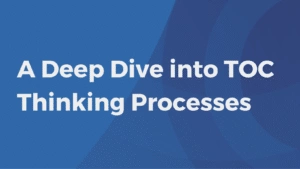In this article, we will delve into the history and evolution of TOC, exploring its origins, core principles, and its enduring relevance in modern business. In the rapidly changing landscape of the business world, companies are continually searching for innovative strategies to gain a competitive edge. The Theory of Constraints (TOC) has emerged as a powerful approach that has garnered significant attention.
Table of Contents
- Origins of TOC
- The Goal Era
- Throughput Accounting and The Haystack Syndrome Era
- Thinking Processes and The It’s Not Luck Era
- Critical Chain Project Management
- TOC’s Continuous Evolution
- Conclusion
Origins of TOC
Early Development
The history of TOC begins with the groundbreaking work of Eliyahu Goldratt in the early 1980s. Goldratt, an Israeli physicist and business consultant, embarked on a mission to find solutions for companies grappling with resource constraints. This quest led to the early development of TOC, a methodology aimed at optimizing production processes and resource allocation.
The Birth of OPT
In 1979, Goldratt introduced “Optimized Production Technology (OPT),” designed to increase output in firms facing resource constraints. Despite garnering attention in the USA, OPT lacked clarity, and academic interest remained limited. Nevertheless, the significance of TOC would soon become apparent.
The Goal Era
Alex Rogo’s Story
TOC’s turning point arrived with the publication of Goldratt’s book, “The Goal,” in 1984. This best-selling business novel narrates the story of Alex Rogo, a factory manager confronted with a critical order delay of seven weeks. Alex’s journey in the book highlighted the core principles of TOC and introduced the concept of constraints within a system.
The Five Focusing Steps
“The Goal” introduced the Five Focusing Steps (5FS), a pivotal element of TOC. These steps involved identifying constraints, exploiting them, subordinating other processes to the constraints, elevating constraints, and repeating the cycle. These steps provided a structured approach to continuous improvement within organizations.
Throughput Accounting and The Haystack Syndrome Era
TOC’s evolution continued with a focus on performance measurement systems. The concept of “Throughput Accounting” emerged, emphasizing both financial and operational metrics.
This framework aimed to align actions with improved financial performance, providing organizations with a clearer understanding of their overall health.
Thinking Processes and The It’s Not Luck Era
In 1994, Goldratt published “It’s Not Luck,” introducing “Thinking Processes” (TPs). TPs offered a systematic approach to identifying and resolving unstructured business problems. These processes provided logical tools to address factors hindering organizations from achieving their goals.
Critical Chain Project Management
Recent years have witnessed TOC’s application in project management through “Critical Chain Project Management.” This approach optimizes project schedules and resource allocation, leading to more efficient project execution.
TOC’s Continuous Evolution
Today, TOC has evolved into a comprehensive management philosophy applicable across various sectors. Whether in production, logistics, supply chain, project management, accounting, research and development, sales, or marketing, TOC offers valuable insights and tools for improvement.
TOC’s journey is far from over. As technology advances and competition continues to intensify, TOC will undoubtedly adapt and evolve to meet the ever-changing needs of the business world.
Conclusion
Over the course of its history, TOC has transcended its origins as a production planning tool to become a versatile and enduring management philosophy. Its evolution over the years has paved the way for businesses across various sectors to achieve higher efficiency, profitability, and success. As TOC continues to evolve, its impact on the business world remains profound.
References















